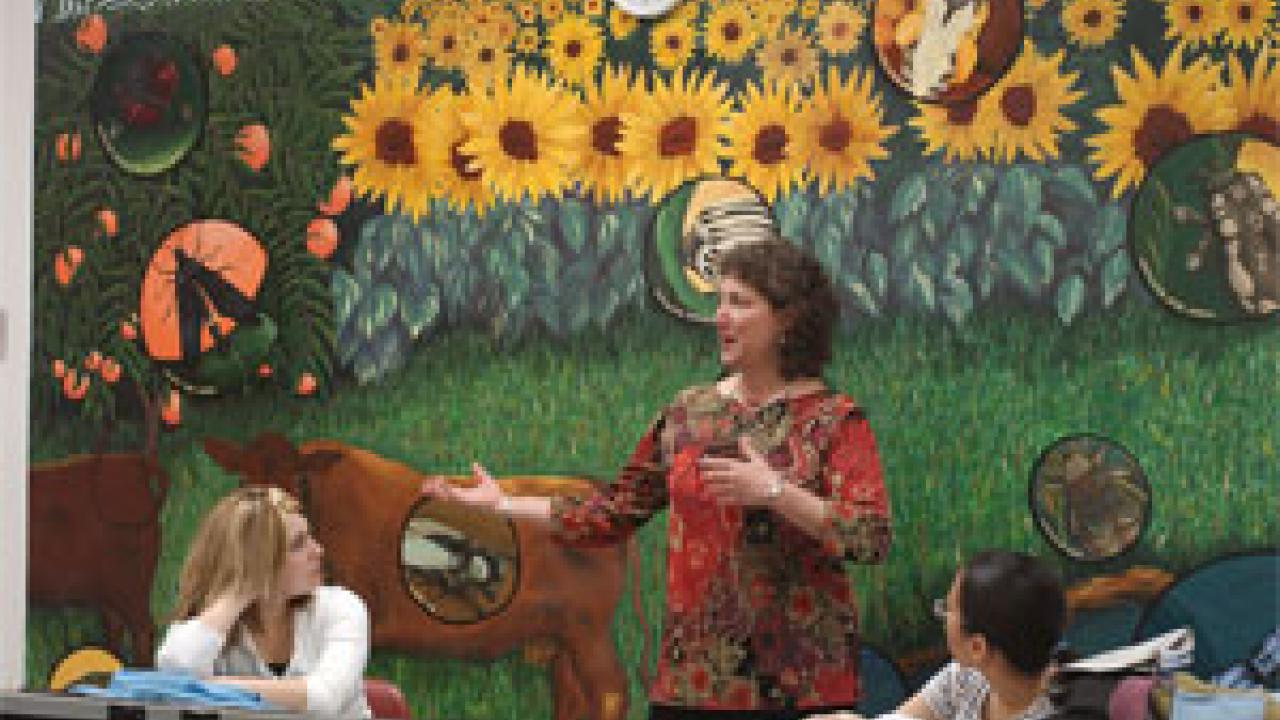The shapes of student artwork in entomology professor Diane Ullman's classes do not represent mere abstractions, but the miniature marvels of the insect world, from beetles to butterflies and bees. In the big picture, all those squiggles, splashes and swirls reflect the unity of knowledge and, perhaps, the shape of art to come on campus.
This fusion of art and science, Ullman says, is powerful because it provides a new avenue for understanding nature's patterns, one that reaches beyond disciplines and challenges the way we view our relationships with the natural world.
To this end, Ullman this quarter is teaching a freshman seminar, Scientific Illustration in Public Murals, where students discover how art infuses and enlivens scientific observation and experimentation.
It is not just a classroom exercise, Ullman says, but fodder for emerging public art efforts at UC Davis. Student projects to illustrate insect classification, biodiversity and natural history have resulted in numerous ceramic mosaic and painted murals on the halls and in the classrooms of the entomology department, where Ullman is chair.
"The translation of the educational process into public art on campus extends the learning process to all those who experience the pieces long after the student creators complete the courses," said Ullman.
Ullman says she is excited about expanding the use of art-science fusion on campus: "This educational strategy makes science accessible to arts and humanities students who otherwise might be afraid of it, and on the flip side, gives students focused on the sciences access to art."
Artistic input
The public art concept follows the campus's strategic focus on "learning, discovery and engagement." Indeed, Ullman's seminar focuses on "the use of graphics in large-scale public murals to convey scientific concepts and to express ideas and relationships with the community that are particular to a specific site."
Provost and Executive Vice Chancellor Virginia Hinshaw is a strong supporter of using public art to pursue the campus's strategic goals.
"The fusion of science and art provides enhanced learning experiences for our students by visualizing the scientific information they are learning and expanding their knowledge of different disciplines," Hinshaw said. "Their creations can well be used to enhance the appearance of campus buildings and open areas."
With guidance from Ullman and graduate student Sarina Jepsen, the 10 students in the freshman seminar will collaborate with a small group of students from Davis High School in the design of a mural on the walls of the Third and B Teen Center.
"Our expectation is that the students will collaborate and develop creative design ideas," said Ullman, noting that the mural will be located near the popular Davis Farmers Market, "so these themes are very appropriate for the site."
Through the years, Ullman has received artistic input for her classes from Donna Billick. A Davis artist who creates large-scale public art, Billick has an undergraduate degree in genetics and a master's in fine art from UC Davis.
Ullman says, "Billick's creativity and artistic skills have been greatly appreciated by students who viewed her as a role model for independence and success as an artist."
Billick met Ullman when the latter came to her art studio about eight years ago seeking to learn about ceramics and clay. "Diane knew all these creatures so well from her science," Billick recalled. "She was a natural artist."
Public art focucs
Collaborating with Ullman is Pam Ronald, a plant pathology professor and faculty assistant to Hinshaw who first brought the art-science concept to the attention of the Provost.
For Ronald, the public art concept makes good sense. "The idea is that when you walk into a building you know what type of learning or research occurs in that building."
One effort would involve the remodeling project of Robbins Hall to include large-scale public art. Already plans are in the works to adorn the building's walls with rice drawings by students at Cesar Chavez Elementary School. The project was done in collaboration with the Plant Genomics Program, which Ronald chairs, as part of a Picnic Day celebration on Saturday.
As part of this project, Becky Bart, a graduate student in Ronald's lab, lectured to the fifth- and sixth-grade students on DNA and explained how DNA affects the appearance of rice plants. She also brought in flowering rice plants for the students to draw. The National Science Foundation supports the partnership with Cesar Chavez school.
Imaginative instruction
Five years ago, Ullman introduced this seemingly incongruous match of science and art into Entomology 1: Art, Science and the World of Insects. In the class, students learn about science by working with textile banners, ceramic sculptures and mosaics, pen-and-ink drawings, paintings and computer graphics.
"We make it fun, fascinating, interesting and educational," she said.
A ready audience exists among students for this type of imaginative instruction, she says. After all, one of the greatest minds of human history, Leonardo da Vinci, was both an artist and a scientist. Maybe that is it — a great thinker knows no boundaries.
"Many students come to campus not sure of what they want to become," said Ullman. "A class like this shows how they can combine different interests and maybe build a career and life that is of their own choosing."
Ullman says students ultimately benefit. "I'm very committed to enriching the learning experience of my students and my own education. That's why I chose an academic career and why lifelong learning and public art are very important to me."
Hinshaw agrees. "I often think about the value of public art for our campus, especially since every day I appreciate the eggheads on my way to work," she says. "Art contributes to our lives and, in my view, refreshes our souls and minds."
Media Resources
Clifton B. Parker, Dateline, (530) 752-1932, cparker@ucdavis.edu
